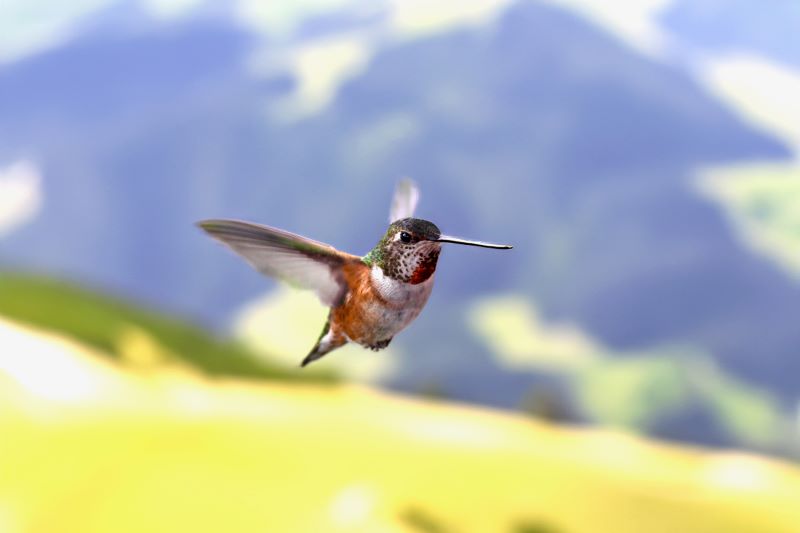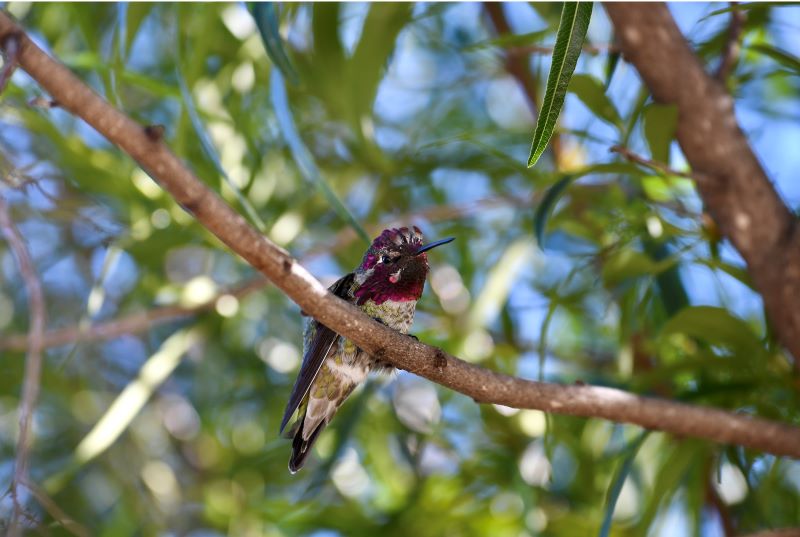New research from the RVC unlocks the key to hummingbird flight
New research from the Royal Veterinary College (RVC), UCLA and the University of British Columbia has found that hummingbirds create a 3D map of their body, which may enable them to hover and make nuanced adjustments to their flight dynamics based on the smallest of touches and airflow in their environment. The findings of this research not only contribute to the understanding of how animals perceive and navigate the world around them but also helps identify more humane ways to work with and treat these birds. This work may also aid development of technology for prosthetic devices that use touch, autonomous vehicles, robotics, and flight sensors on unmanned drones.

Research already exists into hummingbird flight mechanics, however, much less is known about their sense of touch and how this influences their movements – for example, their ability to perform rapid flight manoeuvres or hover near flowers to sip nectar. Previous studies investigating touch processing in the brain have primarily been performed in mammals, but the organisation of avian brains differs from mammals. Furthermore, within birds we have observed neural specialisations related to unique behavioural demands.
This new study, published in Current Biology, reveals how hummingbirds create a 3D map of their body when neurons in two parts of the forebrain fire in response to the intensity of air pressure and light touch. This is influenced by factors, such as proximity to an object, and is detected by nerve cells at the base of the feathers and skin on their legs. These signals are transmitted to the brain which then enables hummingbirds to adjust their body in relation to an object. It is also further supported by receptors on their bill, face and head which likely play a role in sensory control of feeding.
Conducting this study, the team of researchers, led by Dr Andrea Gaede, Lecturer in Locomotor Biomechanics at the RVC, and Dr Duncan Leitch, Assistant Professor of Integrative Biology and Physiology at UCLA, observed neurons firing in real time by outfitting hummingbirds and zebra finches with electrodes. They then touched them gently with cotton swabs or puffs of air, while a computer amplified the signals from the electrodes and converted them to sound for analysis.

The analysis found that touch for the head and body is mapped in different regions of the forebrain and, for the first time, established that air pressure activates specific large clusters of neurons in these regions. Further examination of the wings also revealed a network of nerve cells that likely sends a signal to the brain when activated by the puffs of air on the feathers, enabling the birds to adjust flight in a nuanced way.
Additional findings include:
- The feet of hummingbirds and zebra finches are acutely sensitive to touch and that this touch has large representation in the brain, which may help with perching.
- In hummingbirds, the receptive fields to touch on the bill, face and head were very small, meaning they could sense the lightest touch.
- Zebra finches had the same receptive fields, but these were larger in size, suggesting that these regions in finches are not as sensitive and therefore less relied upon for flight mechanics and movement compared to hummingbirds.
Alongside supporting animal wellbeing, insights from these findings will help with designing engineering systems for autonomous vehicles and uninhibited aircraft (drones), by providing the basis of new bio-inspired sensors to improve flight control. It can also aid the development of prosthetic devices and other robotic applications that use touch sensors to guide movement or perform tasks.
Dr Andrea Gaede, lead author of the paper and Lecturer in Locomotor Biomechanics at the RVC, said:

“By comparing hummingbird and zebra finch neural responses to touch, we identified body regions that are highly sensitive to tactile information, which may be important for impressive hummingbird flight dynamics or other ecologically relevant behaviours in both species.
“Understanding how animals use touch to perceive their environment may help influence designs of autonomous systems that rely on flow sensing or touch and may also help us prevent human-caused disruptions and stress to wildlife.”
Dr Duncan Leitch, Assistant Professor of Integrative Biology and Physiology at UCLA and lead contact of the paper, said:
“In mammals we know that touch is processed across the outer surface of the forebrain in the cortex. But birds have a brain without a layered cortex structure, so it was a wide-open question how touch is represented in their brains.
“We showed exactly where different kinds of touch activate specific neurons in these regions, and how touch is organized in their forebrains, with hummingbirds often reacting to the slightest thresholds we could give them.”
Notes to Editors
Reference
Gaede et al., Variations in touch representation in the hummingbird and zebra finch forebrain, Current Biology (2024), https://doi.org/10.1016/j.cub.2024.04.081.
The full paper is available from Current Biology and can be accessed here: https://doi.org/10.1016/j.cub.2024.04.081
For media enquiries, please contact:
- Jasmin De Vivo at jasmin.devivo@plmr.co.uk or rvc@plmr.co.uk
- Press Line: 0800 368 9520
About the RVC
- The Royal Veterinary College (RVC) is the UK's largest and longest established independent veterinary school and is a Member Institution of the University of London.
- It is one of the few veterinary schools in the world that hold accreditations from the RCVS in the UK (with reciprocal recognition from the AVBC for Australasia, the VCI for Ireland and the SAVC for South Africa), the EAEVE in the EU, and the AVMA in the USA and Canada.
- The RVC is ranked as the top veterinary school in the world in the QS World University Rankings by subject, 2024.
- The RVC offers undergraduate and postgraduate programmes in veterinary medicine, veterinary nursing and biological sciences.
- The RVC is a research-led institution, with 88% of its research rated as internationally excellent or world class in the Research Excellence Framework 2021.
- The RVC provides animal owners and the veterinary profession with access to expert veterinary care and advice through its teaching hospitals and first opinion practices in London and Hertfordshire.
